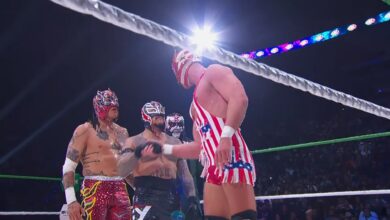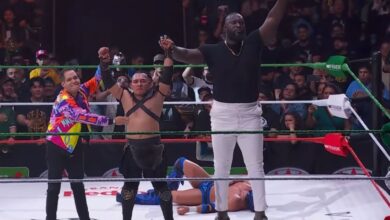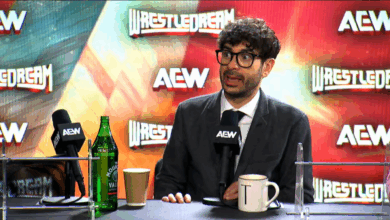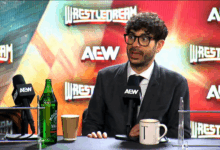Mike Bailey: Striking In Wrestling Is An Incredibly Complex Art Form
Mike Bailey discusses the art of delivering strikes and the art of professional wrestling. Not only is he talented in both the wrestling ring and as a trained martial artist, but he has also led numerous seminars on how to throw a strike properly in the squared circle.
While promoting the new documentary, Keep It Kayfabe, “Speedball” Mike Bailey was interviewed by Fightful’s Sean Ross Sapp. During the discussion, Bailey talked in detail about how to properly throw a strike in a pro wrestling match. Quickly nerding out and getting into the weeds on the topic, he spoke about why he feels throwing strikes in wrestling matches is an art form and why it needs to be more than just hurling punches at a guy.
“If you want to talk, if you want to nerd out about strikes in pro wrestling, you can get me going for easily three hours. I’ve given several seminars on how to strike in pro wrestling,” he said. “But I think this is a good selling point for Speedball Mike Bailey in All Elite Wrestling, as well as Keep It Kayfabe, the documentary that’s premiering at San Diego. Striking in pro wrestling is an incredibly complex art form. More than just hurl your hand at a guy. Hurl your hand at a guy, specifically punches, or the use of multiple punches.
“The use of the punch as a placeholder in pro wrestling is something that only works when you have a camera crew that knows that’s what you’re doing and is going to be on the same page with you,” he continued. “It’s incredible how differently you need to strike, if you’re going to be wrestling in front of 200 people that are going to be basically at ringside, arms length from the ring, and how you have to strike when you are in a 20 foot ring, there’s going to be 12 feet between the ring and the first row, and then there’s going to be 200 rows of people in the audience that are going to extend two miles out.”
Approaching the topic from his martial arts background, Bailey explained the importance of believability, actually making contact with your strike, and allowing the kayfabe aspect of the strike to take place after making contact.
“So what I found very quickly coming from martial arts to pro wrestling is that if you want the audience to really understand the strike that you give, it needs to make contact and the fake part happens, the safe part happens, the pro wrestling part of the strike happens within the contact,” he said. “If you watch movies, they throw the strikes and the camera conveniently shows that your heel doesn’t actually make contact with the guy’s jaw, that’s great but in professional wrestling you have an audience on all four sides.
“So if it looks completely fake to one side and then real to only one side, what’s the point of striking? So that’s when contact, which is the main thing you need to know for pro wrestling striking, you need to be able to make hard contact with safe parts of your body to safe parts of your opponent’s body. The more rotations, the more you have to rely on your opponent to be in a certain position to take it, the more difficult it becomes. That’s where the risk versus reward ratio comes into play. You got me going and I could keep going for another two hours. I don’t have that kind of time.”
Mike Bailey then discussed a match he had with Hijo del Vikingo that is featured in the documentary. He used the match to explain the beauty of wrestling and the trust that occurs between two strangers, because, at the time, he hadn’t met Vikingo. Also, they do not speak the same language, but they were able to come to an understanding through the shared language of professional wrestling.
“That is the beauty of pro wrestling,” he said. “I think that’s what is presented so well in the documentary is that kind of trust that needs to happen between two complete strangers. Again that match that I had with Hijo del Vikingo that is documented in Keep It Kayfabe, we do a he’s standing on the post of the ring—I’m standing on the apron and he gives me a flipping pile driver to the apron, Which is all of it, we’re trying very hard to make this stuff look as dangerous as possible, but being very careful about the selection of the move.
“Again, I don’t know this man,” he continued. “I’ve never met Vikingo in my life. We don’t speak the same language, but we’re going to figure out a method where he is going to make it look as much as possible, like I am going to be paralyzed for life, but actually not do it. Because it’s very close. Again, if he keeps his legs too extended, I’m screwed. If he bends his leg too much, it’s gonna look bad and we’re gonna look ridiculous. If I don’t catch him, if I’m one step out too far, he falls on his head. If I’m one step to the left, he falls on the steel beam on the side of the ring and gets injured. We’re playing very, very close to potentially life-threatening injury, so we really need a method, and that method is professional wrestling, to make sure that we’re able to ride that line safely as often as possible. In this case, 11 times in three days.”
The Keep It Kayfabe documentary, which premiered worldwide at San Diego Comic Con. For more details on the film, check out an interview with the documentary’s directors, Christian O’Keefe and Michael Priestley, now available on Fightful Select.
Check out the full interview with Bailey embedded above.




